The Catastrophe at Caporetto
On 24 October 1917, the Central Powers launched a massive offensive at Italy’s north-eastern border. The resulting battle – popularly known as Caporetto – has been described as the greatest defeat in Italian military history.
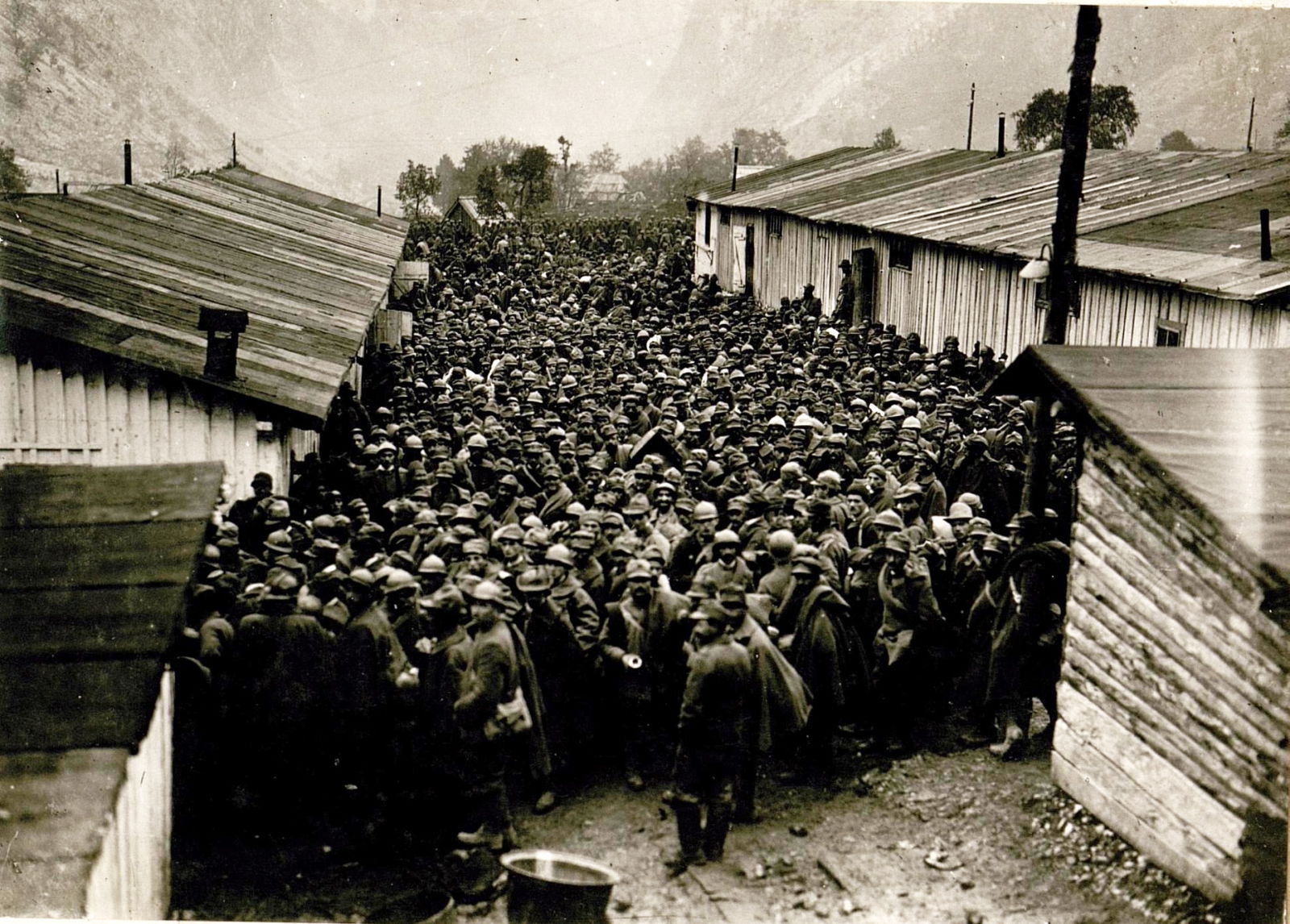
When Italy declared war on Austria-Hungary on 23 May 1915, it did so fuelled by optimistic visions of territorial conquest. It hoped to seize the largely Italian-speaking regions around Trento and Trieste at the country’s north-east border. Nationalist rhetoric held that acquisition of these areas – along with parts of Dalmatia – would complete the process of unification which had taken place in the second half of the 19th century. ‘Italians want a greater Italy, by conquest not by purchase, not shamefully but through blood and glory’, proclaimed the firebrand poet Gabriele D’Annunzio.
By late 1917, however, fatigue had set in even among the war’s supporters. Little apparent progress had been made on any front, casualties were high and the country’s economy was suffering badly. Soldiers in the Italian army hoped that the winter of 1917 would offer some respite. It did not. As rumours of an imminent Austro-Hungarian attack circulated, the Italian army sought to reinforce the mountainous north-eastern battle lines around the town of Caporetto (today Kobarid in Slovenia). The town was positioned on the western side of the Isonzo River, which had partially formed the boundary between Italy and the Austro-Hungarian Empire before the war. By October 1917, the front lines ran some six or seven miles east of the river, along the heights of mounts Ursig, Nero and Rosso. Caporetto had been selected by the Central Powers as the target for a major offensive because of the weakness of the Italian defence there.
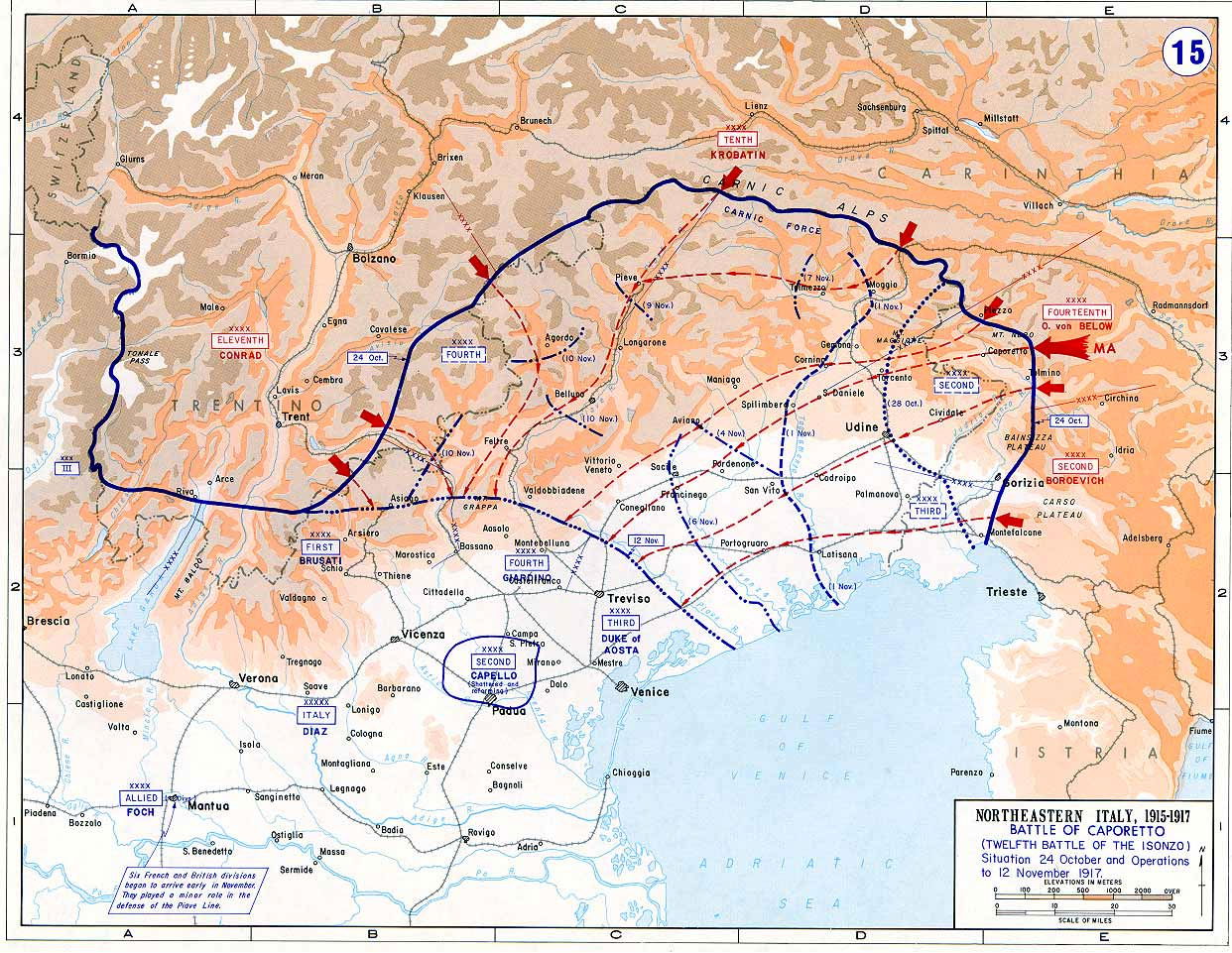
When the expected offensive was launched on 24 October, the resulting battle lasted over a month and was a disaster tantamount to a national trauma. We can witness its opening stage through the eyes of Colonel Francesco Pisani who, as acting general of the Foggia Brigade, found himself and his division part of the Italian drive for reinforcement when he was ordered to Caporetto on 23 October 1917. His brigade had been involved in heavy fighting during the summer in the successful conquest of the Bainsizza plateau, and was now in a state of disarray. He hoped Caporetto would be a quiet posting. The units under his command were struggling with large numbers of green, poorly trained soldiers. Pisani led his men towards divisional headquarters at Caporetto overnight through torrential rain and thick fog. They had barely reached the front-line in the early hours of 24 October when an intense enemy bombardment began along the entire north-eastern line.
At dawn, though Pisani and his men did not know it, nine Austro-Hungarian and six German divisions under Otto von Below had launched a major offensive. Germany had agreed to support its ally in what was hoped would be a decisive attack on Italy before winter made campaigning impossible. Domestic tensions in Austria-Hungary, caused by the growing desire for autonomy among the empire’s many nationalities, made it imperative to seek victory as quickly as possible. The Central Powers’ plan was to smash through the Italian lines, advancing through the valleys to isolate and encircle the Italian defenders who were holding the high ground, before pushing on westward towards the rivers and plains of Friuli-Venezia-Giulia. The Foggia Brigade were advancing directly towards the focal point of this attack.
As the morning wore on, orders arrived from divisional headquarters redirecting most of the Foggia Brigade’s battalions to other nearby destinations where they would reinforce other units struggling under the Central Powers’ assault. As the remaining members of the brigade moved towards Caporetto, they began to encounter large numbers of troops retreating down the same narrow mountain road that they were ascending, bringing with them terrible stories about the fighting ahead. After reaching divisional HQ at Caporetto, Pisani and his men were sent to defend the vital Eiffel Bridge. This was one of the few crossings over the fast-flowing Isonzo, which lay in a deep gorge. If the bridge were lost, several Italian divisions on the east bank of the river and on the mountain slopes above it would be entirely cut off. As German units infiltrated the area, encircling the high peaks of Mount Nero and Rosso up ahead, large numbers of Italian troops were seeking to retreat to the relative safety of the west bank and of Caporetto itself. Without the Eiffel Bridge, this evacuation would be impossible.
The divisional commander had ordered a general retreat and abandoned control of the town to the Foggia Brigade. Pisani later described his task in his official post-battle debriefing:
There was total confusion, the road was almost entirely blocked by a mass of troops, carts, horses, trucks, artillery pieces, mules, and supplies. Officers' cars were unable to make any headway, and it was very hard to execute or even transmit any orders. At this point, the various components of the Brigade became separated, in the chaos, the freezing fog and the rain.
We also tried to organise transport for the wounded, many of who had been abandoned in the road. We could hear them groaning through the fog, and it was imperative to move them since their presence was demoralising the defenders of the bridge.
By mid-afternoon, Italian army headquarters in Udine, some 25 miles away, were still in complete ignorance of the scale of events. Not until 10pm would Chief of General Staff Luigi Cadorna learn the true dimensions of what the Italian troops were suffering at the country’s north-eastern boundary. The situation was a catalogue of woe: indecisive senior commanders, munitions shortages, information blackouts, missing officers and communication breakdowns all worked against a few desperately stretched individuals doing their best to contain the German assault under driving rain and freezing fog.
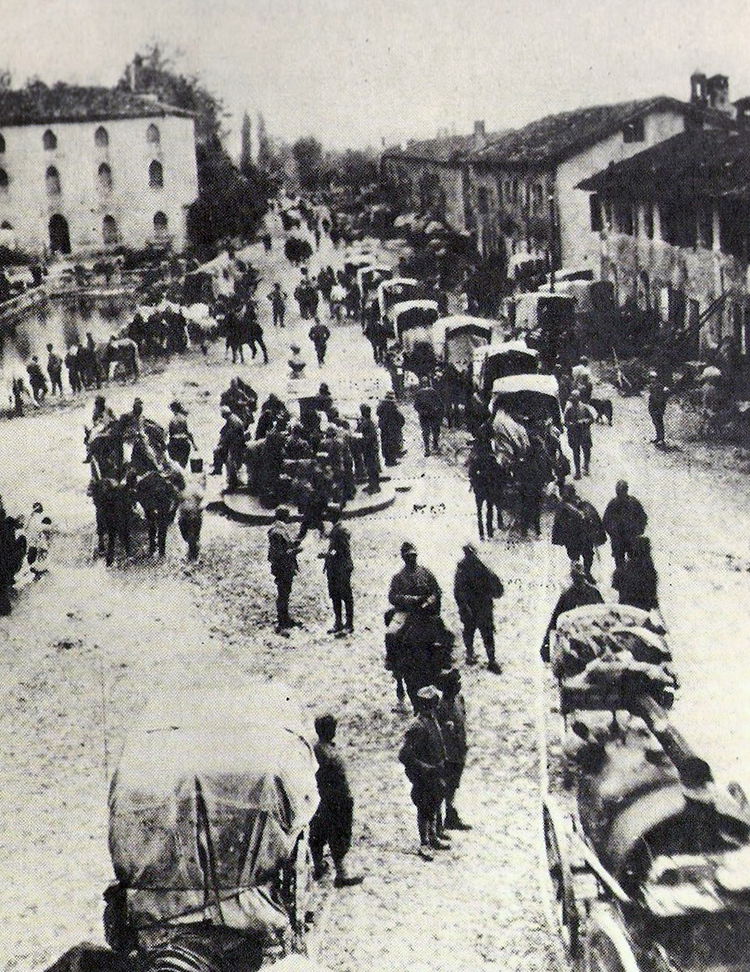
At around 3pm on 24 October, Italian engineers blew up the Eiffel Bridge that the Foggia Brigade was supposed to be defending. At least two Italian divisions were trapped on the eastern side of the river, their retreat cut off. Pisani described the scene:
There was no immediate command in the town of Caporetto itself. The order to destroy the bridge must have been given by a senior officer – but when? Perhaps it had been issued in an uncertain and unclear fashion. I concluded that the decision must have been based on the supposition that the enemy was still on the east bank of the Isonzo – but this was not at all the case, and given that the Germans had already crossed the river [further to the south], the destruction of the bridge served no useful purpose.
I was ordering the rearrangement of our remaining machine gun posts for a better defence of the position, at about 17.00, and my few staff and I were making our way from one post to another when we suddenly found ourselves confronted by a large group of German soldiers. We had no idea the enemy had approached so close. Concealing themselves in one of the half-ruined buildings along the road, they were able to ambush and encircle us easily. Threatening us with rifles and bayonets, the enemy disarmed us so quickly that there was barely time to even think.
This was the end of Pisani’s war; captured with his staff, he was despatched to a prisoner of war camp at Karlsruhe in Germany. Leaderless and isolated, the Foggia Brigade stood little chance. Most of the patrols Pisani had sent out in search of information had already been surrounded in the fog. By the end of the day 3,577 of its men had been taken prisoner, while the Central Powers had advanced around 14 miles, seizing bridges, and were established on the west bank of the Isonzo. Around 20,000 Italians were captured that day and by the time the battle ended, a month later, more than 280,000 had been taken by the enemy, almost half of all those captured during the war.
*
The opening phase of the battle, from 24 October to 3 November, was the most damaging to Italy. The chaotic scenes and mass captures that Pisani witnessed were repeated up and down the peaks and valleys of the north-eastern front. As enormous numbers of troops began to retreat, often without munitions and officers, panic set in and a disorderly mass flight began. By 27 October, the Supreme Command was no longer confident that even the ‘extreme’ line of defence, nearly 45 miles away on the river Tagliamento, would be able to hold. This was where Italy’s last prepared defensive positions were located, but Chief of General Staff Cadorna began to contemplate a further withdrawal to the river Piave. The next day, he and his staff abandoned their headquarters at Udine and joined the retreat. The first enemy troops reached Udine at around 3pm; it would soon become the new Austro-Hungarian HQ. The retreating Italians reached the Tagliamento on 31 October. By 3 November the enemy, too, had reached this river, as Italian troops fell back towards the Piave, around 100 miles behind the original front.
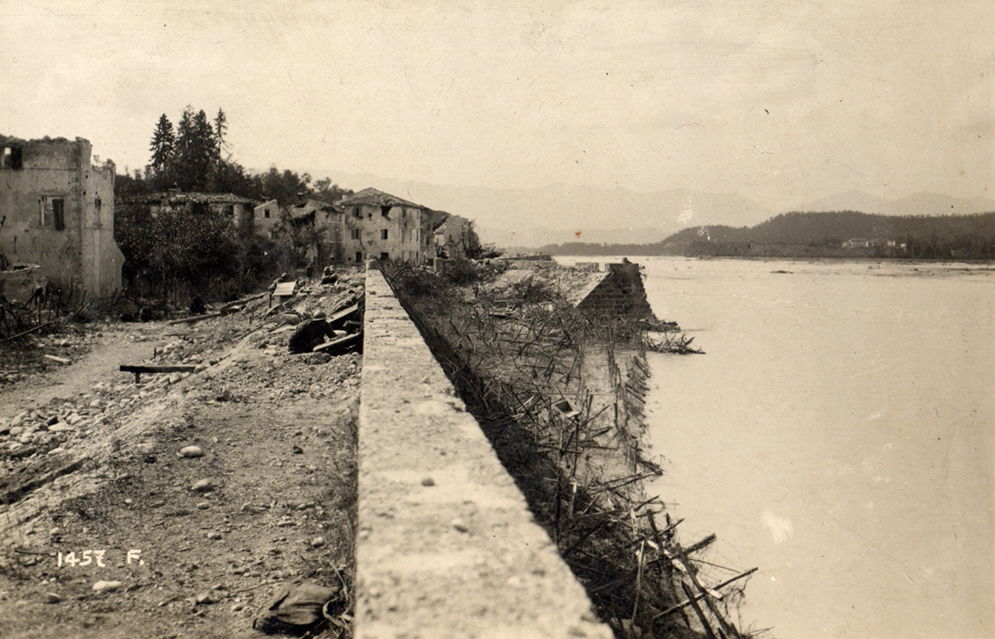
In the first five days of the battle, huge numbers of Italians were captured but as the retreat continued losses were increasingly caused by desertion. Hundreds of thousands of soldiers fled back into Italy from the positions they had conquered in the first two and a half years of the war. Luigi Albertini, editor of the daily newspaper Corriere della Sera, visited the front on 30 October 1917. ‘For the most part, the troops did not fight. When sent forward they discarded their weapons and returned unarmed’, he reported. Many men claimed that they had been told that the war was over, so it was not only permissible but sensible to head home. In total 300,000 men were ‘scattered’ during the battle. It was impossible to say whether they had voluntarily absconded or simply got lost in the chaos of the retreat.
*
The speed and extent of the Austro-German offensive had taken the Italian forces by surprise, but it was equally unexpected to the attackers themselves. As a result, they struggled to capitalise on their advance. Bringing up fresh troops and keeping their artillery moving forward proved difficult owing to fleeing civilians, broken bridges and disordered roads, which had also delayed the Italian retreat. This gave the Italians time to regroup. In the second phase of the battle, beginning once the Italians had reached the Tagliamento on 3 November, they began to recover their fighting capacity as the demoralised forces were replaced by more solid and resilient troops drawn from the reserves and from the Alpine front in the north, which had been untouched by the Central Powers’ attack. The retreat was controlled and disciplined. Gradually the line stabilised, taking up a new defensive position on the Piave on 9 November. The new front, which was maintained until October 1918, was hundreds of kilometres shorter than the original and thus more easily manned. The terrain, too, was more hospitable, allowing for more effective lines of communication.
The third and final phase of the battle started on 12 November and lasted for six days. The Austro-German offensive was renewed, with a final push to break through Italian lines towards Venice. British intelligence reported that ‘Germany and Austria count on the collapse of Italy during the coming winter’. But the push was unsuccessful: the Piave line held, with support from French and British forces, who took over their own sections on 21 November. The battle finally ended on 26 November as the new front stabilised. The front line would remain in this position until the final weeks of the war.
By the battle’s conclusion more than 5,000 square miles of Italian territory was in enemy hands. In addition to the hundreds of thousands of prisoners and dispersed soldiers, the Italian army also lost 40,000 soldiers who were either killed or wounded during the battle. German and Austro-Hungarian casualties numbered 50,000. Over one million civilian refugees had been forced to flee from the advancing Austro-German troops; many more remained trapped in occupied territory, suffering death, sickness and deprivation under Habsburg military rule.
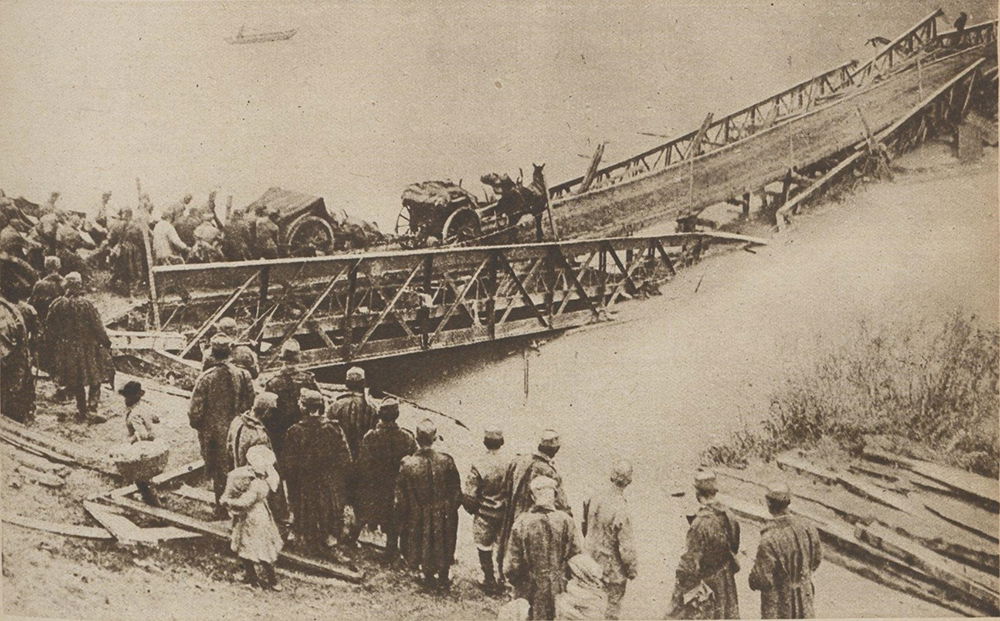
Italy’s losses were not limited to land and people. The young Lieutenant Erwin Rommel, fighting south of Caporetto with the Württemberg Mountain battalion, recollected with pleasure the ‘chocolate, eggs, preserves, grapes and white bread’ which his troops seized and which made their morale ‘wonderful!’ Over 10 million ration sets, and more than six million tins of fish or meat, were among the Italian supplies captured by the advancing Central Powers forces, along with 1,309 tonnes of dried pasta, 645 tonnes of cheese and 253 tonnes of coffee. Of even more interest to Rommel’s men, perhaps, was their share of the captured wine (five million litres) and cognac (1,600 litres). The Italians also lost significant stores of clothing and bedding: 966,000 coats and waterproofs, 69,000 hats, 320,000 pairs of boots and 1.5 million pairs of pants and socks along with 295,000 sheets and blankets. Engineers lost more than 17,000 tonnes of essential material, while thousands of trucks and tens of thousands of horses and mules – with their fodder – were abandoned to the enemy. Some 3,000 artillery pieces and a similar number of machine guns were lost, which Italy could ill afford given its shortages of these essential weapons. Several field hospitals with all their beds, iodine and medicines were taken. The loss of significant amounts of coal meant that Italy became dependent on imports from its allies.
*
The consequences of the defeat were dramatic and a great deal of national soul-searching followed with immediate changes at the highest levels. The prime minister, Paolo Boselli, was replaced by the experienced liberal lawyer Vittorio Orlando. Cadorna was forced out. His high-handed, inflexible leadership was unpopular with civilian politicians and his military abilities had been questioned even before the catastrophic events of Caporetto. Orlando did not want to work with him and nor did the Allies, whose representatives arrived in Italy at the end of October. The allies met at Rapallo, near Genoa, on 5 November, with the battle still raging. They agreed to support Italy and created the Supreme War Council (SWC), a kind of allied general staff. This offered an ideal way to remove Cadorna, who was shifted ‘upwards’ into the SWC, and replaced as Chief of the General Staff by Armando Diaz, a younger, more dynamic and tactful general. Diaz would transform the army’s training, formation-level tactics, morale, command structures, leave policies and more. Where Cadorna had stifled initiative and confidence – sacking and demoting commanders at the drop of a hat – Diaz was more open to suggestions and to delegation.
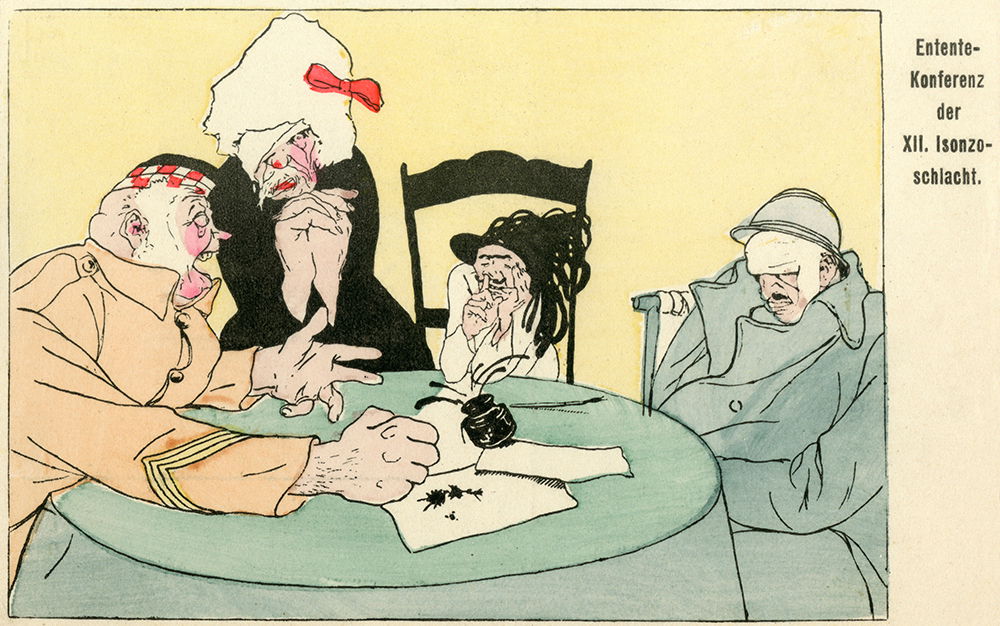
Cadorna’s dismissal suggested that he was responsible for the defeat, but allocation of blame caused a political row, beginning within 48 hours of the initial attack. Concerns about disaffection and defeatism among the troops had been growing. The authorities feared that ‘subversive’ socialist propaganda was destroying the army’s fighting spirit. Cadorna was quick to advance this interpretation. On 28 October he had declared that ‘the inadequate resistance of units of 2nd Army, cowardly retreating without fighting or ignominiously surrendering to the enemy, has permitted the Austro-German forces to break our left wing on the Julian front’. This was damaging to the Italian army’s image both nationally and internationally. The Italian ambassador to London recalled that even George V made disparaging comments about the Italian troops’ performance. Attributing blame for defeat on the soliders was oddly endorsed by elements of both the right – who saw it as proof of socialist-inspired cowardice and pacifism – and the left, who interpreted it as a ‘military strike’, which demonstrated that the masses had turned against the war.
In truth, it is unfair to claim that the frontline units who faced the Austro-German assault on 24 October or the days after failed to fight. The Foggia Brigade’s experience of conflicting orders, inadequate supplies and unsuitable defensive positioning was representative of the whole. Many reports suggest that the men fought bravely with determination for as long as they had officers and munitions. Once these two essentials were lost it was hard to keep a positive outlook, as a battalion commander from the 224th infantry regiment recalled:
On the night of 23 October my men were in good spirits but by the end of the next day they were less confident. By the end of 25 October, the unit had become mixed with others, the men had not slept for 24 hours and had no more munitions. At this stage they became ‘morally prisoners’ and in a state of depression began to accept the prospect of capture and imprisonment.
Under these circumstances large groups of men could be captured by small enemy detachments. The Italian army’s defence strategy was also responsible for the defeat. Cadorna had decided to hold the mountainous peaks at all costs while neglecting the valleys below; the Germans simply advanced with speed through these valleys, encircling the defenders on the peaks. Caporetto was a devastating military defeat, but it was one with clearly identifiable strategic, operational and tactical causes.
*
The battle almost immediately assumed the name of the town where the decisive breakthrough had been made and soon became an emblem of Italian military failure. For decades it was associated with anti-war sentiment, desertion and cowardice. The novelist Carlo Emilio Gadda, who was trapped and captured after the premature destruction of the Eiffel Bridge, described his experience as one of ‘spiritual horrors’. In a sense, the whole country reacted this way. Pisani wrote that ‘the sacrifice of blood made by the regiments could not hope to dam up the invading tide’; that tide swept away two and a half years worth of gains, made at the cost of hundreds of thousands of lives. Italy’s victory in the First World War came in the battle of Vittorio Veneto, symbolically (if coincidentally) launched on 24 October 1918. Yet the scars left by Caporetto were hard to heal. The shadows of those foggy, chaotic days in the mountains loomed large into the postwar years.
Vanda Wilcox is the author of Morale and the Italian Army during the First World War (Cambridge University Press, 2016).